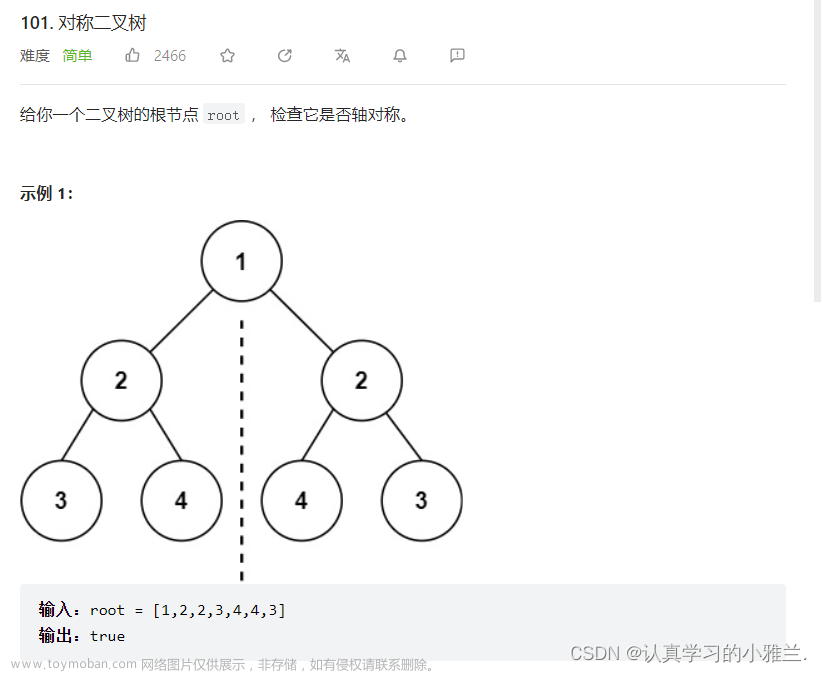一【题目类别】
- 排序
二【题目难度】
- 简单
三【题目编号】
- 1365.有多少小于当前数字的数字
四【题目描述】
- 给你一个数组 nums,对于其中每个元素 nums[i],请你统计数组中比它小的所有数字的数目。
- 换而言之,对于每个 nums[i] 你必须计算出有效的 j 的数量,其中 j 满足 j != i 且 nums[j] < nums[i] 。
- 以数组形式返回答案。
五【题目示例】
-
示例 1:
- 输入:nums = [8,1,2,2,3]
- 输出:[4,0,1,1,3]
- 解释:
- 对于 nums[0]=8 存在四个比它小的数字:(1,2,2 和 3)。
- 对于 nums[1]=1 不存在比它小的数字。
- 对于 nums[2]=2 存在一个比它小的数字:(1)。
- 对于 nums[3]=2 存在一个比它小的数字:(1)。
- 对于 nums[4]=3 存在三个比它小的数字:(1,2 和 2)。
-
示例 2:
- 输入:nums = [6,5,4,8]
- 输出:[2,1,0,3]
-
示例 3:
- 输入:nums = [7,7,7,7]
- 输出:[0,0,0,0]
六【题目提示】
- 2 < = n u m s . l e n g t h < = 500 2 <= nums.length <= 500 2<=nums.length<=500
- 0 < = n u m s [ i ] < = 100 0 <= nums[i] <= 100 0<=nums[i]<=100
七【解题思路】
- 利用计数排序的思想来解决这道题目
- 首先使用count数组来保存每个数字出现的次数
- 然后再次使用count数组来计算小于当前数字和个数和当前数字个数的和
- 对于第i个数字,count[i-1]的值就是小于第i个数字的数字个数
- 需要注意要对数字0进行特殊处理,否则会出现负的索引下标,从而出错
- 最后返回结果即可
八【时间频度】
- 时间复杂度: O ( n + k ) O(n+k) O(n+k), n n n为传入的数组的长度, k k k为传入的数组的值域大小
- 空间复杂度: O ( k ) O(k) O(k), k k k为传入的数组的值域大小
九【代码实现】
- Java语言版
class Solution {
public int[] smallerNumbersThanCurrent(int[] nums) {
int[] count = new int[101];
int n = nums.length;
for(int i = 0; i < n;i++){
count[nums[i]]++;
}
for(int i = 1; i < 101;i++){
count[i] += count[i - 1];
}
int[] res = new int[n];
for(int i = 0;i < n;i++){
res[i] = nums[i] == 0 ? 0 : count[nums[i] - 1];
}
return res;
}
}
- C语言版
int* smallerNumbersThanCurrent(int* nums, int numsSize, int* returnSize)
{
int* count = (int*)calloc(101, sizeof(int));
int n = numsSize;
for(int i = 0;i < n;i++)
{
count[nums[i]]++;
}
for(int i = 1;i < 101;i++)
{
count[i] += count[i - 1];
}
int* res = (int*)calloc(n, sizeof(int));
for(int i = 0;i < n;i++)
{
res[i] = nums[i] == 0 ? 0 : count[nums[i] - 1];
}
*returnSize = n;
return res;
}
- Python语言版
class Solution:
def smallerNumbersThanCurrent(self, nums: List[int]) -> List[int]:
n = len(nums)
count = [0] * 101
for i in range(0, n):
count[nums[i]] += 1
for i in range(1, 101):
count[i] += count[i - 1]
res = [0] * n
for i in range(0, n):
res[i] = 0 if nums[i] == 0 else count[nums[i] - 1]
return res
- C++语言版
class Solution {
public:
vector<int> smallerNumbersThanCurrent(vector<int>& nums) {
vector<int> count(101, 0);
int n = nums.size();
for(int i = 0;i < n;i++){
count[nums[i]]++;
}
for(int i = 1; i < 101;i++){
count[i] += count[i - 1];
}
vector<int> res(n, 0);
for(int i = 0;i < n;i++){
res[i] = nums[i] == 0 ? 0 : count[nums[i] - 1];
}
return res;
}
};
十【提交结果】
-
Java语言版

-
C语言版

-
Python语言版
 文章来源:https://www.toymoban.com/news/detail-681795.html
文章来源:https://www.toymoban.com/news/detail-681795.html -
C++语言版
 文章来源地址https://www.toymoban.com/news/detail-681795.html
文章来源地址https://www.toymoban.com/news/detail-681795.html
到了这里,关于【LeetCode每日一题】——1365.有多少小于当前数字的数字的文章就介绍完了。如果您还想了解更多内容,请在右上角搜索TOY模板网以前的文章或继续浏览下面的相关文章,希望大家以后多多支持TOY模板网!





![LeetCode[315]计算右侧小于当前元素的个数](https://imgs.yssmx.com/Uploads/2024/02/610294-1.png)





